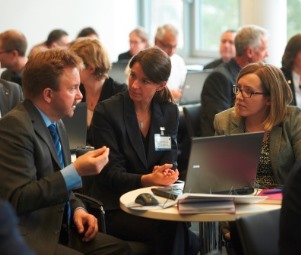KANBrief 2/16

The fourth International Strategy Conference on Occupational Safety and Health was held in Dresden from 21 to 24 March 2016 (Results, photographs and videos relating to all five conference topics). The interactive programme was devoted to the following five topics: Vision Zero, Demographic change, Human-centered prevention, Healthy work – healthy life, and Work in a digital world. KAN was responsible for organizing the last of these topics. Read on to learn the essential results.
The Strategy Conference in Dresden served as an intermediate step before the next World Congress on Safety and Health at Work, to be held in Singapore in 2017. It was attended by around 200 delegates from over 40 countries, who discussed new developments in the world of work. Hans-Horst Konkolewsky, Secretary-General of the ISSA (International Social Security Association), made clear in his opening address that digitalization constitutes one of the mega-trends in occupational safety and health for the coming years. In Topic 5, "Work in a digital world", four questions were examined in more detail in papers and brainstorming sessions.
In what way will work be changed by digitalization?
Sabina Jeschke, Director of an institute cluster for information and knowledge management at the RWTH Aachen, anticipates that in the near future, everything will be networked with everything else. Machines, she says, will learn in the same way that human beings do – by trial and error. But faster, and with results far exceeding anything that human beings can achieve.
The delegates at the conference anticipated fundamental changes to the timing, location and nature of work as a result of increasing networking. Employees will no longer necessarily work from nine to five in offices; they will also work from home, whilst travelling, or at arbitrary times and locations. The boundaries between occupational and private life will blur as a result, and face-to-face contact will be replaced by electronic communication. In view of the deluge of information to which employees are exposed every day, it will become increasingly important to filter out the relevant information.
What general conditions must be in place in order for the digital world of work to be humane?
Work 4.0 calls for occupational safety and health 4.0, said Andrea Nahles, German Federal Minister of Labour in a video clip, representing the position of the German government. The trade unions call in particular for social security to be safeguarded within the digital world of work. A statutory framework and clarification of responsibilities are particularly important in occupational safety and health if the digital world of work is not to end in a regulatory no-man's land. Employers face a change in leadership role. In future, the focus will lie to a greater extent upon creating good working conditions in which employees are motivated and are able to deliver their best efforts. The conference delegates regarded data security as an essential criterion for digital work. Standardization can assist in setting high standards in this area.
What contribution can and should the occupational safety and health lobby make to the process of digitalization?
In the view of Michael Beilfuss of the IDG Media Group, it is essential to understand what digitalization actually means in order for the occupational safety and health lobby to respond appropriately. Digitalization calls for management personnel who are willing to take bold decisions and who do not cling to traditional ways, even when the "right" course has not yet clearly emerged. Occupational safety and health must also be assured for the growing number of crowdworkers who download and complete jobs from the Internet. Customers' measures and resources must also extend to these individuals for this purpose. Occupational safety and health must also make greater use of the potential offered by the "digital natives", and must break the mould.
What tools for occupational safety and health tools must be created or developed further?
A range of digital products were presented, including "Nao", the humanoid robot, a smart jacket for fire-fighters, and data glasses. The delegates hoped that in the future, a wider choice of intelligent products would be available that could deliver precisely the information required at any given location and in real time. The OSH regulations should also be integrated directly into these products, enabling them to issue warnings, display information, or switch themselves off automatically as the situation demands. It is also conceivable that in the future, hazardous or unergonomic tasks could increasingly be performed by robots.
KAN will enlarge upon the results of the Strategy Conference at the IEC General Meeting in October 2016.
Katharina von Rymon Lipinski Sonja Miesner
vonrymonlipinski@kan.de miesner@kan.de